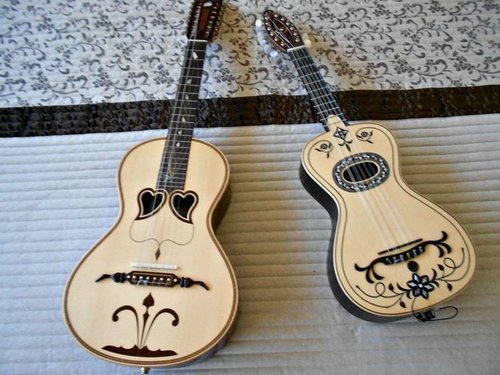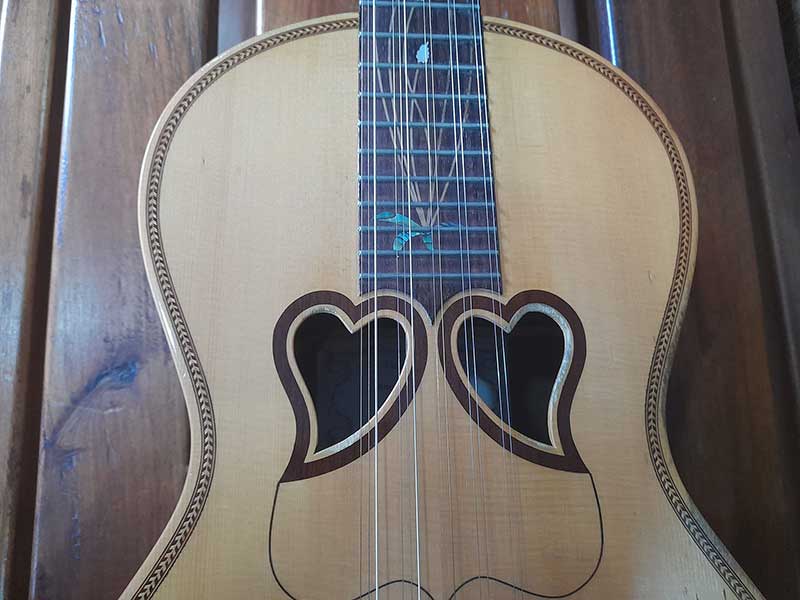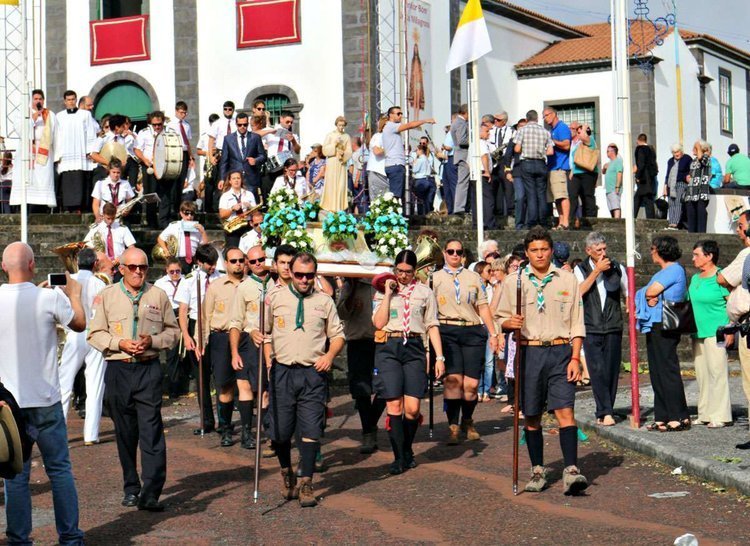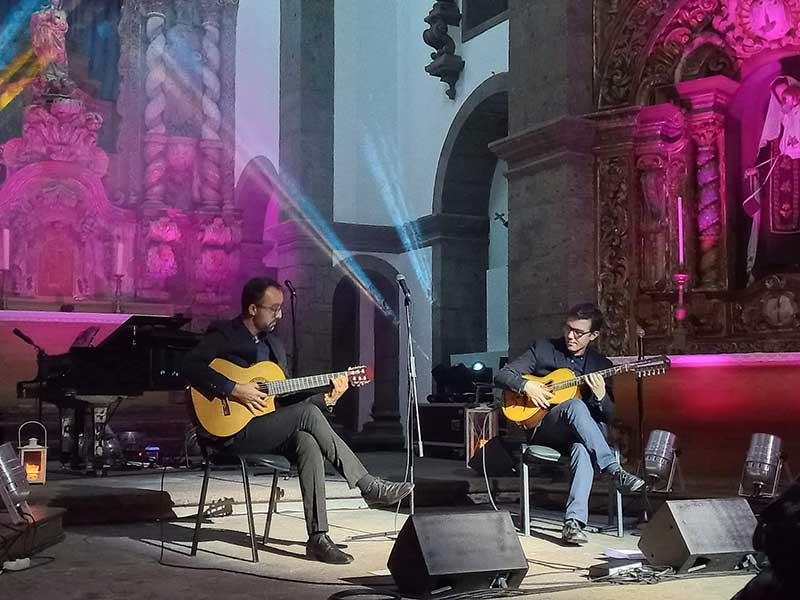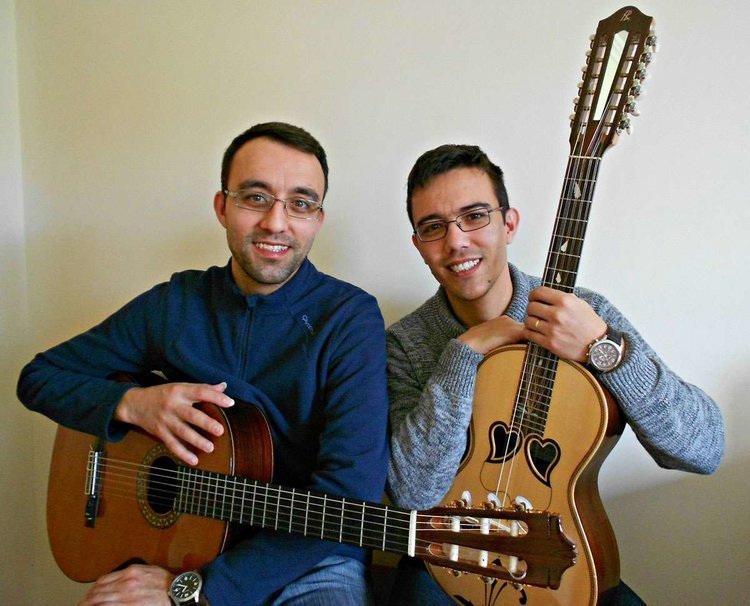Rafael Carvalho is an Azorean musician and teacher whose forte and calling are the viola da terra and the traditional music of the Atlantic archipelago that is his home. He is also a composer who creates contemporary traditional songs.
The term "traditional music" is often used as a broad classification that contrasts the genre with classical and popular music. This means that traditional music is not based on any theoretical forms, nor is it created with a commercial goal of a mass audience. So then what does constitute traditional music? That is a complicated question, but various definitions include music transmitted orally or created by unknown composers, or that has been performed by custom over a long period of time. With the settlement of the Azores archipelago going back to the mid-1400s, its traditional music certainly meets these criteria.
There is also a school of thought that traditional music refers to a way of life that has or is disappearing. In my conversation with Rafael, I learned a lot about the role geographic isolation can play in preserving cultural heritage. While the Azores' position in the Atlantic has meant it has been a port of call on transAtlantic journeys for centuries, its location and volcanic topography has also meant isolation for residents, despite a steady stream of sailors from Europe and the Americas.
But Rafael also reminded me that political agendas can seek to thwart the sense of identity and community that traditional music inspires, something I had learned about first-hand when travelling through Estonia, where traditional music was forbidden under Soviet rule. Rafael gave me a lesson about Portugal's history; I am embarrassed to admit I didn't know that for 40 years, the country was under Fascist leadership. As an autonomous region of Portugal, the Azores were geographically distant from the authoritarian ideologies of dictator António de Oliveira Salazar--but not immune.
Today, Rafael is a leading figure in the revival of traditional music on the Azores--and has played for three of its presidents. While his talents and passion make him an able ambassador, he made clear in our conversation--its a labor of love.
A Short History of the Viola de Terra
Meg: Can you tell me about the instrument you play?
Rafael: The viola da terra belongs to a family of several Portuguese violas, each traditional from a specific region of the country, and is a traditional instrument used in Azorean music.
At the beginning they were all called just viola, but, throughout the time, the instruments evolved within different regions, mostly in how they are tuned, and they began being named for the region to better identify the sound. The viola campaniça literally means "from the countryside" and is played in southeast Portugal. The viola braguesa is from Braga in northwest Portugal; viola Beiroa is from Castelo Branco in eastern Portugal; viola Amarantina is from Amarant in northern Portugal and, on the Azores, we have the viola da Terra.
As the first settlers came to the Azores, so came the first violas, maybe in the eighteenth century. This instrument started to become a part of the Azorean way of life. It’s called viola da terra because it’s from our place, our land. It is also is known as viola de arame because of the wire strings, and viola de dois corações, because of the two heart shapes on its tampo harmónico, or "sound board."
Why the Sound of the Viola de Terra is So Distinctive
The sound of the instrument is very unique and beautiful because it has 12 strings. Three orders of two strings, and two orders of three strings. Those double and triple orders of strings gives the instrument a special and warm sound that is immediately recognizable.
On the Azores, we have one style of viola, but the instrument has three different tunings: D - B - G - D - A on the islands of São Miguel and Santa Maria, and the other seven islands tune like this: E - B - G - D - A; this order is from the highest sound to the lowest. At Terceira Island, the viola has yet another difference because the viola there has 15 strings (E - B - G - D - A - E).
The difference in tuning is not a thing easily noticed, because the violas have double and triple strings, and that is what gives it a special and different sound.
What can be noticed is the different sound that is achieved with different techniques of playing, and the unique melodies that developed in different locales across the Azores. Just as each region of the country has its own "accent," that kind of happens with the music too. The same way we have different gastronomy on each island, different customs, and even different work tools, the development of certain styles occurred with the music, and, especially, with the violas, which are historically the principal instruments here.
That diversity evolved within our islands' isolation. Maybe today, if one kind of tuning was the most known and the one with the most work published, making it easier to have access, people would obviously choose it.
But, we are taking about traditional music from the past. In those days, a lot of people from within the same region, the same island, even from neighboring villages, never got to know each other, never got to play together. The differences came from the different settlers but also from the isolation, from what people could or could not evolve by themselves. Each village has its own variations.
Viola de Terra the Star of Folkloric Festivals
Meg: When and where is the viola da terra performed?
Rafael: Since the Azores were settled, the viola has been played throughout the year, at all the festivities, or after a hard day's work--whenever people want to relax. It was and still is natural for people to relax here by dancing, playing, and singing. It may not be the same as in the past, and not as frequent, but people still get together to enjoy music and each other. Sometimes it is spontaneous, or it can be organized, such as weekly rehearsals of the folkloric groups.
There are folkloric festivals on almost all of the Islands, some with international participation as a result of cultural exchanges. There are also other kind of gatherings organized by associations, public groups, or just by friends wanting to be together and have a good time. Sometimes a dance can just start without being planned at all.
Music has an important role in Azorean society because it has always been the way of gathering people, of having a good time after a long day, of boys and girls getting the opportunity of being together and dancing next to each other. And, the viola has the main role, and provides the boost that makes all this possible.
Celebrating Faith a Way of Life on Azores
Meg: What are some of the organized events at which the viola is played?
Rafael: People play the viola at Carnival dances, the Holy Ghost festivities, and at Christmas, going from door to door, playing and singing, mostly by improvisation, and, all night the strings warm the heart of the Azorean people.
People live their lives according to their beliefs and almost everybody on the Azores follows the Catholic faith. Most of the festivals have that origin, and then people create their own ways of celebrating them. Mass is said every day at some churches at 6:00 or 7:00 a.m. so people can go to church daily before going to work.
The one time of year when the viola is silenced is after the Carnival and during Lent, as an act of respect. It would only be played again at Easter Sunday. Beginning on Ash Wednesday, Lent is a solemn season of reflection and preparation before the celebrations of Easter. Observing Lent replicates Jesus Christ's sacrifice and withdrawal into the desert for 40 days. Because of that way of living and beliefs, are no festivities, dancing, singing, or playing during Lent.
On the Azores, faith and devotion is very strong, or at least it was in the past. A lot of our rituals have origins in seeking comfort from the earthquakes, storms, and other natural problems that hit the Azores from time to time. People would do Promessas or promises to God, just to get some benefits for their families, for the harvest, the animals, or just to prevent storms and earthquakes.
One of these promises is Romarias on São Miguel Island--once a year, men walk across the island by foot for a week, praying and singing. They eat what people give them and sleep in people's homes or in the village churches. Others promise to walk on their knees at Senhor Santo Cristo dos Milagres or Bom Jesus processions.
The most common festival is Holy Ghost Festival or Festa do Divino Espirito Santo, which celebrates the third person of the Godhead. The mysticism involved with the religion and these traditions is a big part of the Azorean way of being.
Each place has their own special traditions, that could be related to blessing the bread, the meat, the cattle, the fishing boats, or other things that have an impact on daily live.
Rafael Discovered His Calling at a Young Age
Meg: When did you begin playing the viola de terra?
Rafael: I discovered the instrument very young because in my hometown, Ribeira Quente, it is played every year at Christmas, from door to door, bringing the baby Jesus to all the houses of my village, as a way of bringing the child's grace to everyone but, also, as a way to achieve funds for the church activities.
As a child I always liked the instrument and the sound. And, at the age of 12, I started to learn violão (6-string guitar) with my father. The next year for the first time there were classes of viola da terra, to teach the musicians of our recently formed Folkloric Group of São Paulo. That was when I started learning with professor Carlos Quental. He lived in Ponta Delgada but was originally from Maia.
I had classes with him for five or six months in 1994 but he had a stroke and stopped teaching. I lost contact with him and only saw him again more than a decade later. He couldn't play anymore and that was a big shock, but it only made me work harder. He always told me that he had taught so that he could pass it to others... and so this became kind of a goal in my life.
Emigration and Politics Cause Viola de Terra to Disappear
Meg: Has the viola been consistently popular on the Azores since the 18th century?
Rafael: The viola has had ups and downs over time. Nowadays the viola is still alive, and in the last decade has been very important for people to give it value again.
We live on a world where everybody says "back in our times, those were the good days. back then we worked hard, had respect, and maintained the traditions..."etc. It feels like that every generation always lives in the shadow of something that once was great!
I don't agree with that. I believe we are responsible for doing what we can today but that work cant be done properly if the older people don't pass on their knowledge. They are responsible, too, if things disappear.
That said, the viola has had both worse and better times.
The emigration, especially since the 60's, was responsible for the viola starting to disappear. Also, new instruments were arriving to the Azores: violão (classical guitar), Portuguese guitar, and the accordion. At the same time as people emigrated, the remaining musicians were getting older, and, most of them simply did not teach what they knew, and the instrument declined very much.
The political situation of the country also affected the popularity of the viola da terra. From 1932 until 1974, Portugal lived in Fascism. During that period, society became very closed, and folkloric gatherings were not well received by the government. So, that was a time when the viola was not played much or taught. Of course, you will always find exceptions and people who battled against that.
I can't tell you that traditional music was banned, or not allowed. What happened is that due to the Fascism situation thousands and thousands of people emigrated, taking away a lot of musicians, singers, and other traditional craftsmen such as builders.
Also, with emigration, even most people that remained stopped playing. It was like they were moaning for the ones that left.
And at the same time, people struggled every day to have bread on their tables. It was a very hard time because to stabilize the country's financial situation, taxes were high and salaries were low, and that came at the cost of people enjoying a good way of living.
What I know about those times is that the people gatherings were not well accepted by the government and the state police. Meaning that, of course, people would rather stay at home than to get into trouble.
My father told me he once wrote some poems about the government, just satirical writing, and he showed it to some friends. Some days later, the PIDE agent (police of the state) warned my grandfather that there could be repercussions if it happened again. My father was welcomed home with a hand slapping.
That is just how it was.
So, I believe that that ambiance of repression affected people being able to to enjoy their lives and, with all the rest of the national problems, was a dark time for people and, consequently, for the viola.
A New Wave of Interest in the Viola de Terra
In the late '80s, 90's, things started to change. There began to be more folkloric groups and more viola courses.
Nowadays we live in the era of globalization and the viola had to find its way into that. So now we have viola social networks, videos online, etc. People won't try to learn what they don't even know exists, and Facebook and YouTube have been a great way of showing the viola to the world. That is the kind of work I do.
And we have, again, a new wave of interest and a lot of young people learning. There is a growing interest across the country for our folkloric music, instruments and traditions.
Isolation of Islands Makes Azorean Music Unique
Meg: How is Azorean music unique and what are its influences?
Rafael: Azorean music is unique because it has been transformed through time and the isolation of the islands. The Azores are at a strategic geographic location in the middle of the Atlantic Ocean. Our influences came from the mainland (Portugal), where the first settlers came from, but also from Madeira Island, Cabo Verde, Spain, Brazil and several other places around the world. As a central location for all who wanted to cross the Atlantic, we received all of those influences, not only musical but in all aspects of life.
Azorean people received these different heritages and made them their own, different from one island to the other, and transformed in each village as the centuries passed by.
Also, each island has its unique music, and that is a very rich part of being Azorean and living or visiting the Azores – there’s always something different that you can find from one place to the other.
Rafeal's Favorite Azorean Folk Songs
Meg: What are three of your favorite folk songs?
Rafael: I like practically all of our traditional music. But within our traditional music, we have some songs that are a reference, not only because of the lyrics or the dancing but mostly because of its instrumental richness.
The main theme of our traditional music, for me, would be “Saudade.” This song represents a lot of what it means to be Azorean, the suffering of living in isolation, the pain of seeing family going away to other countries looking for better life opportunities, and sometimes never hearing from them again, the pain of an unrequited love, and also, the pain of having someone who dies and goes away forever.
On the opposite end of the spectrum, I would choose “Pezinho.” This is a song that is danced on all islands. It has lots of variations but it is one of the most known and danced pieces of music. In some places, people also sing the “Pezinho” in improvisation. But, most of all, there are so many different melodies of this song and some of them really hard to play, that makes the music very interesting.
The third and last would be the “Chamarrita do Pico.” All Azorean Islands have a “Chamarrita,” all of them different, but, at Pico Island, and also at Faial and São Jorge, this is a song that everybody dances. They play it at the festivities, religious or not, they play it all year, and it can last for hours. It’s so spontaneous, it never has the same choreography, anyone can arrive and dance and it’s not rehearsed, That is why it’s my third choice because we are talking of something that is very special, always different.
Rafael Shares His Influences
Meg: Who have been your biggest influences?
Rafael: My first influences started at home. My father played a little of the violão, and my mother was always listening to Amália Rodrigues and Fado. That is something that I know aroused my curiosity.
My main influence was, of course, my viola teacher, Carlos Quental, because of the passion of how he taught and spoke of the instrument and the music. That was the most important. At the age of 13, I came to to love the instrument as soon as I started to learn. I had a few months of classes and, then, had to learn the rest by myself.
After that I started to follow the work of Miguel de Braga Pimentel, his dad had been Carlos Quental's teacher and had a CD of 20 instrumental viola da terra music. I started to learn them by myself.
Through the years I have also been influenced by Carlos Paredes, who died in 2004. He is the main reference, an exceptional musician and man. Carlos was a virtuoso Portuguese guitar player and composer, born in Coimbra, and credited with being responsible for popularizing the Portuguese guitar. He was the son of the equally famous Artur Paredes. Much of today's Coimbra guitar features can be traced back to his contact with local luthiers--someone who builds or repairs stringed instruments; the name comes from the French word for lute.
And, I have also been influenced by all the musicians and students that I have had the pleasure of sharing the stage or just having a good talk with about music or just about life.
Composing Contemporary Traditional Songs for the Viola de Terra
Meg: I believe you compose your own music. Can you describe your style and what inspires you?
Rafael: My compositions don't have a fixed style, but I would say they are contemporary traditional songs. Everything I compose on the viola is based on my journey, learning and people I've met and their influences in me.
I always liked to create music and started to write music and lyrics when I was very young. But those were only to play for friends, and with the guitar, not the viola. At first, I only created small melodies of the traditional music that I played, and would create my own variations of them. When I started to learn more about the viola, and started to explore the sound, some melodies started to appear and if I liked them I would record them myself.
When the years passed I started to compose more structured melodies. The main goal, back then, was to explore the São Miguel and Santa Maria islands technique that is used on the viola, playing only with the thumb. I enjoyed to challenge myself to see how fast I could play, what new sounds I could create and, how I could I maintain the sound of the lowers strings and still do melody on the higher strings.
For a long time, I was embarrassed to play my own music at live concerts. I felt I was exposing myself, my feelings, my life, and was also afraid of the criticism. As the years passed I had good friends and family that gave me the right push in the right direction. I forgot all about the people who criticized my work but never got the courage themselves to try doing something different.
People criticize the new compositions, and others also criticize me because I teach people the "secrets" of the instrument that they think that should only be from the knowledge of some of us. But that comes from their own insecurity and, even their own inability of playing the instrument on stage with no mistakes and being able to talk knowledgeably about the viola. At the same time, hardly anyone composes for the instrument, and only a few assume to have the patience and knowledge to teach.
I believe that if you criticize then you have the obligation of doing better or at least of sharing other points of views. If you cant do that, then just don't criticize at all.
Nowadays, I have been composing a lot. Sometimes I just start playing and exploring the sounds and something new shows up. Other times I have people asking me for new music and I try to understand what they want and how can I express that.
The inspiration comes and goes. A big part of it is living on the islands, and all the references that I have and the state of mind that I have at that moment. That defines my style, that comes from who I am, and is, mostly, trying to find a beautiful and simple melody, and then work and develop it.
I have edited two CD: “Origens” in 2012 and “Paralelo 38 in 2014. I have been working for the last two years on new music and started recording my third álbum, which I hope will be out by the summer.
Teaching Students Aged Six to 82
Meg: How long have you been teaching music and what do you consider to be the rewards and challenges?
Rafael: I started teaching viola da terra at the age of 15. When my teacher got sick, I had to start teaching others on my village. Not because I was an expert, but because I knew more songs than the others. After that I taught several classes in my hometown through the years, then at Povoação Academy, at Fajã de Baixo Viola School, and, for the past nine years I have taught full-time at the Music Conservatory, the official music school of São Miguel Island. There I have students from the age of 6 to 22 but, at other schools where I teach, the age varies a lot, and I have students from all ages. The oldest is 82.
I work under a contract that is renewed every year but despite the enormous success and the actual demand for more teachers, there is no guarantee that next year they will contract me--or send me home.
I love teaching, always have, since the first class I gave at the age of 15. There are a lot of challenges, mainly nowadays teachers have lost their authority, their value, and the respect of most of the society. However, the most important of all is the students.
With the viola da terra the challenge is to captivate students, show the instrument, explain its history and amazing sound. I normally say that if someone really sees the instrument they will never forget it, and we have increased the classes number every year.
At the same time, as a traditional instrument, there are no teaching books and no material to use in working with students, even at an official music school. That was another challenge that made me have to work and publish three books of my viola da terra method.
Despite having to “compete” with the globalized appeal of the classic instruments, like the piano and violin, and also the classical guitar, and, at the same time having to create material to work with, this has been a great journey and the best reward is to see the students evolving, the happiness of learning the first song or the first chords, and how happy they are doing public presentations. That work has generated new musicians who start to appear, and new projects like, for example, my Viola da Terra Orchestra Project.
The Viola da Terra Orchestra Project started in 2011. I created the project with musicians from across the island of São Miguel. For one weekend we work on traditional music and prepare a concert where we include other types of musicians like piano, violin, percussion, flute or bass players, as well as a vocalist, and we do an annual concert. One year we gathered 47 viola da terra players. The main goal is to keep people motivated and try to teach, each year, one or two new songs. Our reward will always be more personal than financial.
Viola de Terra is Something You Have to Hear, Feel and Live
Meg: What do you think is important for people to know about Azorean music?
Rafael: The most important feature of my music, and Azorean music, for me is how genuine it is. Simple, beautiful but very warm and meaningful. It comes from the people, from their humility, from the inner strength, from our way of suffering in silence but, at the same time, to celebrate life very loudly, with family, friends, neighbors, in a big dance of “Chamarritas” or in a special house to house visit.
The friends we make because of the viola are truly faithful friends. Simple people, great artists, that really understand the viola struggles. There is a lack of recognition for traditional music. Those of us who play it always have to do twice as much as everybody else. We all know that we will always be poor but that shared struggle and life goal bring us together as a brotherhood. So, we don't have to talk about it, we just know it.
I have played for lots of people--the president of the government, in Brussels for the former prime minister of Portugal Durão Barroso, for the prime minister of Cape Verde. And I have met a lot of great viola musician from other places, like Vitor Sardinha (Madeira), José Barros, Pedro Mestre, Amadeu Magalhães and Chico Lobo (Brazil).
So I think my music reflects who I am and where I live. I've said many times that after I learned viola, my life changed for the better and became a great journey.
When I talk about isolation, I speak mostly of the past, of those times people would only have contact with the rest of the world when a ship arrived...Nowadays people don't understand that. I still feel that we have a big physical isolation that we can try to overcome with technology, but this is still the Azores, the islands, the mist, the solitude.
And, as much as I can try to explain the music of the viola da terra, there will never be enough words. You just can't explain it, you have to hear it, feel it and live it.
Interested in learning more about the Azores? Check out this pieces!
- Carina Costa of the Terra Nostra Park, Azores
Publisher and editor of People Are Culture (PAC). This article was created by original reporting that sourced expert commentary from local cultural standard-bearers. Those quoted provide cultural and historical context that is unique to their role in the community and to this article.

